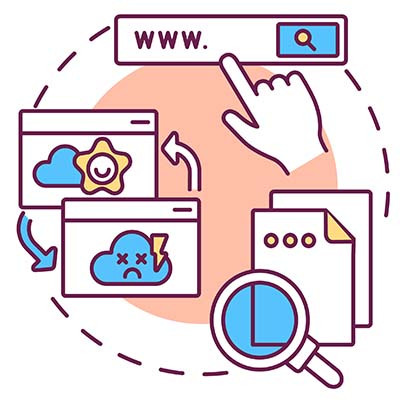It’s all well and good for us to recommend that you avoid phishing attacks and infected attachments simply by not clicking on the links in emails and other popular vectors of attacks, but the fact of the matter is that you might need to click on one at some point. In this case, it’s best to check the link before clicking it, and we’re here to offer tools to help you do so.
Computerware Blog
Your business depends on its wireless connectivity, but you might notice that there are various factors that can influence how well your devices can connect to your wireless networks. We’ve put together a shortlist of things that can get in the way of your Wi-Fi connection and what you can do to avoid them.
Nowadays, businesses are turning to the cloud to help resolve more and more of their daily challenges, and for good reason—generally speaking, the cloud can handle most everything thrown at it. However, are we becoming too reliant on cloud services? Let’s try to strike a balance between the pros and cons of the cloud and our dependence on it today.
Most businesses use the Internet to conduct many of their day-to-day operations, and the most-used ways that people interact with the Internet is through web browsers. That said, there are some ways that you can make sure you are using the Internet in the most secure way possible. Here are some extra steps you can take to work toward these protections.
Connectivity to high-speed, broadband Internet has quickly transitioned from a convenient luxury to a practical need for personal life and business alike. Considering this, it seems amazing that Internet access isn’t nearly as equally distributed as the need for it is. However, the Federal Communications Commission is calling on the public to help them change that by downloading an application that they first released in 2013: FCC Speed Test.
While it seems decidedly commonplace nowadays, the Internet is undeniably a miracle of the modern age—shrinking the world in a way never seen before. Of course, this has complicated things considerably in terms of the rules that the Internet must comply with, based on regional regulations. Let’s reexamine the impact that these laws, regulations, and restrictions have had on how the Internet appears across the globe.
It is undeniable that technology has become ingrained into our workplaces, and perhaps even more so into our daily lives—particularly considering the events of the past few years. This is likely why it is so surprising when a large tech company bans a user for some activity on their platform.
With all that is happening today, this surprise has largely turned into outrage over whether or not these companies can really ban people over what they share on the platform. Let’s go over the situation to try and glean from it some answers.
It wasn’t long ago that we took the time to discuss what format is best while you’re sharing images, whether via email or online. The idea was that images with the smallest file sizes were best, as they could be shared and downloaded more rapidly—without a tradeoff in terms of quality. Let’s discuss how this can be accomplished in Photoshop.
Images are immensely useful tools to communicate, whether using them online or sharing them in an email. Having said that, understanding a few things about image files and their sizes will help you to use these images more effectively. We’ve put together this guide to make it easier for you to put images to their proper use.
Regardless of what you use it for, having the right amount of bandwidth to support your business’ needs is extremely important. Not only does it support enhanced productivity, collaboration, and business efficiency, it removes the bottlenecks that can stymie a business’ progress. Today, we will take a look at bandwidth, and tell you how to determine the bandwidth you need to support all of your business’ Internet-facing needs.
Google—the name that has become synonymous with searching online, it is (if we’re being totally honest) the go-to means of seeking out the information we need. We’ve all used it, but did you know that there are tricks to make your searches more efficient? For this week’s tip, we’ll go over these tricks so that you can use Google Search that much better.
The COVID-19 outbreak has been a trying time for businesses and individuals, alike. Not much positive has come from it, as people, who typically band together in times of unease, are asked to stay away from each other. This has led to many people turning to their smartphones and Internet connections to communicate with the people they hold dear. With a national reliance on Internet connections there have been some new voices (and some familiar ones) advocating for the return of net neutrality. Today, we’ll remind you what net neutrality is and why this situation has people calling for a change.
In light of the coronavirus outbreak that swiftly swept across the globe, there have been efforts made by many telecommunications companies to make life easier for their customers. These customers are likely holed up at home, working remotely if possible. One way or another, they are going to want Internet access, and in a show of solidarity, numerous ISPs and cell carriers are delivering.
Efficient use of modern information technology should make business faster and more agile. No matter how you set your business up, however, a slow Internet connection can be a real drag on business. Today, we wanted to go over some scenarios you should know about when your Internet connection is holding your business back; and, solid practices that you can use to get the Internet speeds you need to move business along efficiently.
Businesses’ data needs are changing. Over the past few years, more care about data security, and with the amount of dangerous threats expanding as well, it is important to ensure that any technology moves you make don’t end up putting your business in harm’s way. Today, we’ll talk about the pros and cons of wiring up your computer network.
Depending on the company, the Internet connection is perhaps the most important part of its IT infrastructure, especially if it has remote workers or multiple offices connected by a Wide Area Network (WAN). Other technologies such as VoIP, screen-sharing, and webinars also benefit from optimized bandwidth. Today, we’ll talk about bandwidth, what your company’s needs are, and how to get the Internet service that is right for you.



















